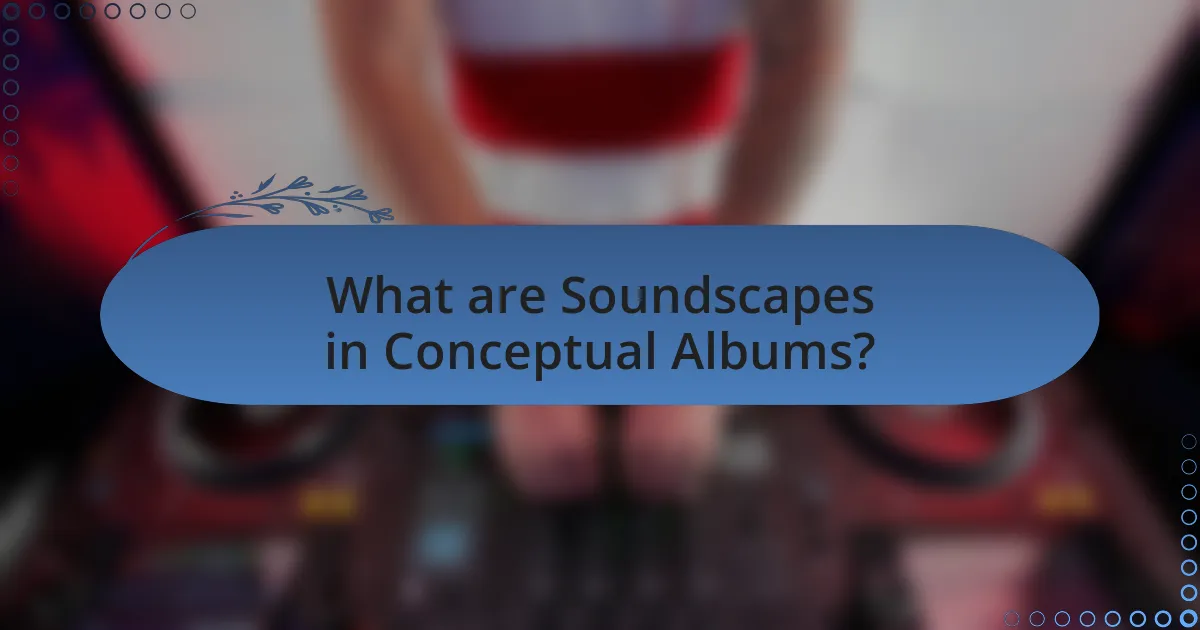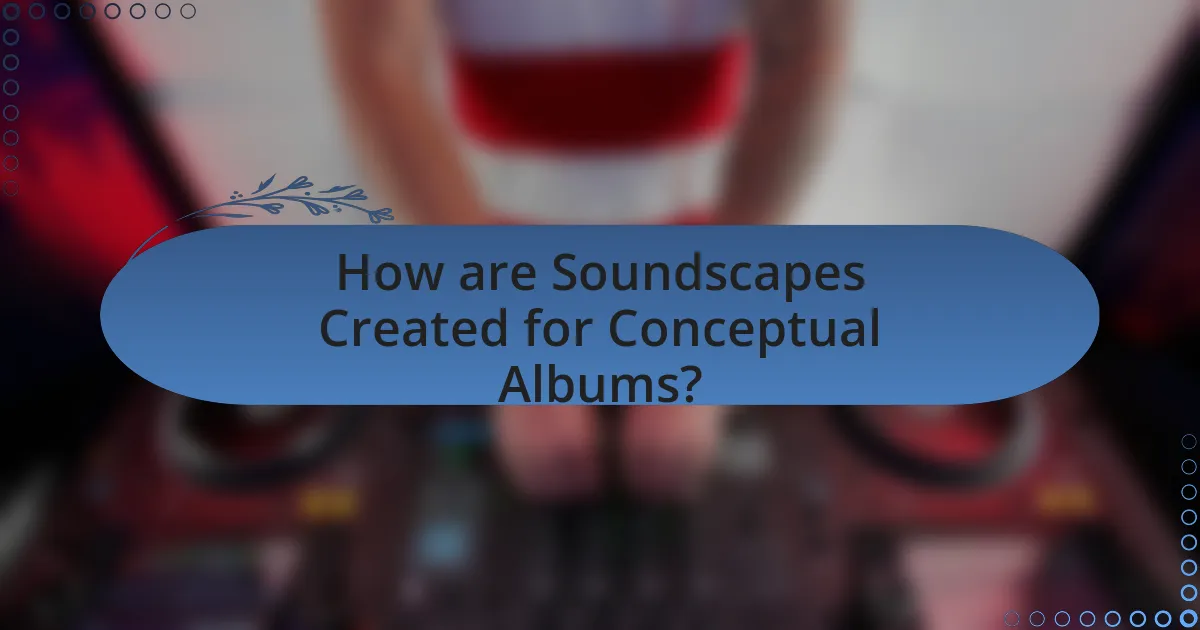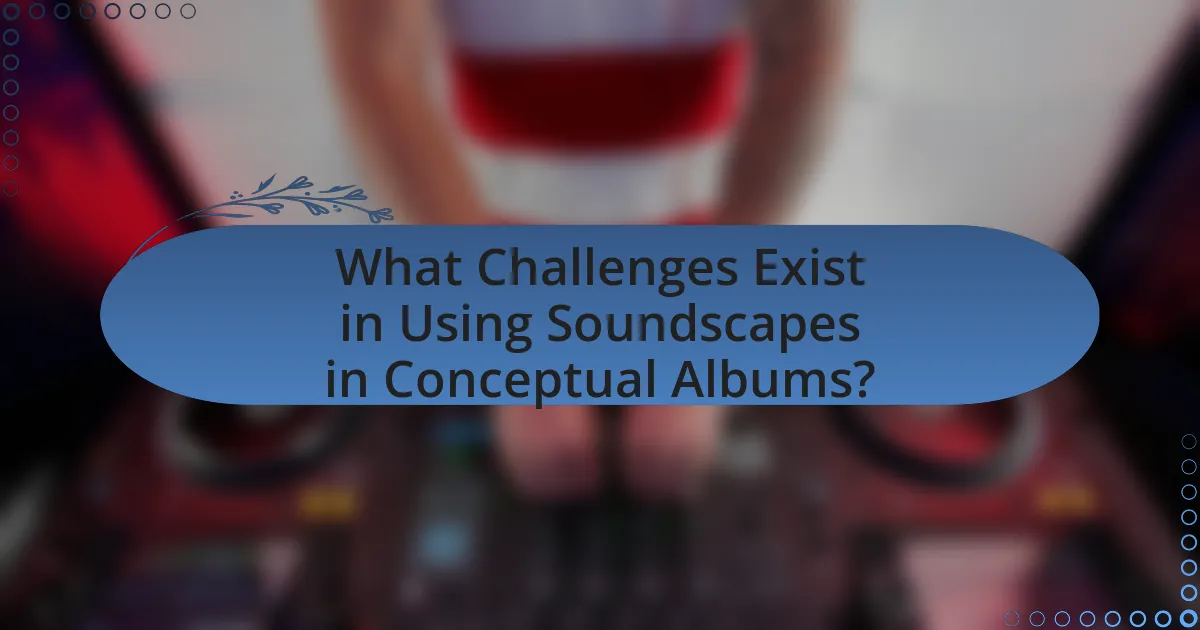Soundscapes in conceptual albums are auditory environments that combine music, sound effects, and ambient noises to enhance the thematic narrative of the album. This article explores how soundscapes contribute to storytelling by creating immersive experiences that evoke emotions and establish context. Key elements of soundscapes include ambient sounds, musical motifs, and narrative audio clips, which differ from traditional compositions by focusing on environmental textures rather than structured melodies. The article also addresses the challenges artists face in integrating soundscapes, best practices for effective use, and notable artists who have successfully employed soundscapes in their work.

What are Soundscapes in Conceptual Albums?
Soundscapes in conceptual albums are auditory environments created through a combination of music, sound effects, and ambient noises that enhance the thematic narrative of the album. These soundscapes serve to immerse the listener in the album’s story or concept, often reflecting emotions, settings, or events that align with the overarching theme. For example, Pink Floyd’s “The Dark Side of the Moon” utilizes soundscapes like heartbeat sounds and spoken word snippets to convey themes of time and mental health, effectively reinforcing the album’s conceptual framework.
How do soundscapes enhance the storytelling in conceptual albums?
Soundscapes enhance storytelling in conceptual albums by creating immersive auditory environments that complement and deepen the narrative. These soundscapes provide contextual background, evoke emotions, and establish a sense of place, allowing listeners to engage more fully with the album’s themes. For instance, the use of ambient sounds, such as nature or urban noise, can set the scene for a story, while musical motifs can signify character development or plot progression. Research indicates that soundscapes can trigger emotional responses, making the storytelling experience more impactful and memorable.
What elements constitute a soundscape in this context?
Elements that constitute a soundscape in the context of conceptual albums include ambient sounds, musical motifs, and narrative audio clips. Ambient sounds create an atmospheric backdrop, while musical motifs provide thematic continuity throughout the album. Narrative audio clips, such as spoken word or sound effects, enhance storytelling and emotional depth. These elements work together to immerse the listener in a cohesive auditory experience, as evidenced by albums like “The Dark Side of the Moon” by Pink Floyd, which integrates various soundscapes to convey complex themes and emotions.
How do soundscapes differ from traditional musical compositions?
Soundscapes differ from traditional musical compositions primarily in their focus on environmental sounds and textures rather than structured melodies and harmonies. Traditional musical compositions typically emphasize rhythm, melody, and harmony, often following established forms and structures, while soundscapes prioritize the auditory experience of a specific environment, capturing the essence of a place through natural and artificial sounds. For instance, soundscapes may include recordings of nature, urban environments, or everyday life, creating an immersive experience that evokes a sense of space and atmosphere, as seen in works by artists like Brian Eno, who pioneered ambient music that emphasizes sound texture over traditional musical elements.
Why are soundscapes important in the realm of conceptual albums?
Soundscapes are important in the realm of conceptual albums because they enhance the narrative and emotional depth of the music. By integrating ambient sounds and audio textures, artists create immersive environments that support the overarching themes and stories within the album. For instance, Pink Floyd’s “The Dark Side of the Moon” employs soundscapes to reflect on mental health and the passage of time, effectively drawing listeners into the conceptual framework. This use of soundscapes not only enriches the listening experience but also allows for a more profound connection between the audience and the artistic vision, making the album a cohesive work of art rather than just a collection of songs.
What emotional responses do soundscapes evoke in listeners?
Soundscapes evoke a range of emotional responses in listeners, including relaxation, nostalgia, and heightened awareness. Research indicates that natural soundscapes, such as those featuring water or birdsong, can significantly reduce stress and promote feelings of tranquility, as demonstrated in studies by Bratman et al. (2015) published in the Proceedings of the National Academy of Sciences. Additionally, soundscapes can trigger memories and emotions associated with past experiences, leading to feelings of nostalgia, as shown in work by Janata (2009) in the journal Music Perception. Furthermore, immersive soundscapes can enhance focus and creativity, as evidenced by findings from the University of California, Irvine, which highlight the positive effects of ambient sounds on cognitive performance.
How do soundscapes contribute to the overall theme of an album?
Soundscapes significantly enhance the overall theme of an album by creating an immersive auditory environment that complements the lyrical and musical content. These soundscapes can evoke specific emotions, set a mood, or establish a narrative context, thereby deepening the listener’s engagement with the album’s concept. For example, in Pink Floyd’s “The Dark Side of the Moon,” the use of ambient sounds and effects, such as heartbeat and clock ticking, reinforces themes of time and mental health, making the listening experience more profound and cohesive. This integration of soundscapes not only supports the thematic elements but also helps to unify the album as a complete artistic statement.

How are Soundscapes Created for Conceptual Albums?
Soundscapes for conceptual albums are created through a combination of field recordings, synthesized sounds, and layered instrumentation that reflect the thematic narrative of the album. Artists often begin by defining the concept or story they wish to convey, which guides their selection of sounds that evoke specific emotions or settings. For instance, Brian Eno’s ambient works utilize environmental sounds and electronic textures to create immersive experiences that align with the album’s themes. This method allows for a cohesive auditory experience that enhances the listener’s understanding of the conceptual framework.
What techniques are commonly used in crafting soundscapes?
Techniques commonly used in crafting soundscapes include field recording, layering, and sound manipulation. Field recording involves capturing real-world sounds to create an authentic auditory environment, while layering combines multiple sound elements to build depth and complexity. Sound manipulation techniques, such as reverb, delay, and pitch shifting, further enhance the auditory experience by altering the characteristics of the recorded sounds. These methods are essential in conceptual albums, as they help convey themes and emotions effectively, creating immersive listening experiences.
How does field recording play a role in soundscape creation?
Field recording is essential in soundscape creation as it captures real-world audio environments, providing authentic textures and atmospheres. This technique allows artists to incorporate natural sounds, such as wildlife, urban noise, or environmental elements, directly into their compositions, enhancing the immersive quality of the soundscape. For instance, the use of field recordings in conceptual albums like “The Disintegration Loops” by William Basinski demonstrates how these recordings can evoke emotional responses and create a sense of place, grounding the listener in a specific auditory experience.
What software and tools are essential for producing soundscapes?
Essential software and tools for producing soundscapes include Digital Audio Workstations (DAWs) like Ableton Live, Logic Pro, and Pro Tools, as well as sound design software such as Native Instruments Kontakt and Spectrasonics Omnisphere. These tools enable users to manipulate audio, create layered textures, and incorporate various sound elements effectively. DAWs provide a platform for recording, editing, and mixing sounds, while sound design software offers extensive libraries and synthesis capabilities, crucial for crafting immersive soundscapes. The combination of these tools is widely recognized in the industry for their effectiveness in soundscape production.
Who are some notable artists known for their use of soundscapes?
Notable artists known for their use of soundscapes include Brian Eno, Aphex Twin, and Sigur Rós. Brian Eno is often credited with pioneering ambient music and has created influential soundscapes in albums like “Music for Airports.” Aphex Twin, known for his innovative electronic compositions, incorporates intricate soundscapes in works such as “Selected Ambient Works 85-92.” Sigur Rós utilizes ethereal soundscapes in their music, particularly evident in their album “Ágætis byrjun,” which blends atmospheric textures with traditional instrumentation. These artists exemplify the effective use of soundscapes in their conceptual albums, enhancing the listening experience through immersive audio environments.
What specific albums exemplify the effective use of soundscapes?
“Dark Side of the Moon” by Pink Floyd exemplifies the effective use of soundscapes. This album integrates various sound effects, such as heartbeat sounds and spoken word segments, to create an immersive auditory experience that complements its themes of time and mental health. Another notable example is “Kid A” by Radiohead, which employs electronic textures and ambient sounds to evoke a sense of disconnection and modernity. Additionally, “Ambient 1: Music for Airports” by Brian Eno is a seminal work in soundscapes, designed specifically to create a calming atmosphere in public spaces, showcasing the potential of ambient music to influence mood and perception.
How have these artists influenced the genre of conceptual albums?
These artists have significantly influenced the genre of conceptual albums by integrating intricate soundscapes that enhance storytelling and thematic coherence. For instance, Pink Floyd’s “The Dark Side of the Moon” employs innovative sound effects and transitions, creating an immersive experience that aligns with its exploration of mental health and existential themes. Similarly, Radiohead’s “OK Computer” utilizes electronic elements and atmospheric textures to convey feelings of alienation and societal critique, setting a precedent for future artists to prioritize sonic environments in their narratives. This trend has led to a broader acceptance of experimental sounds in conceptual works, encouraging artists to push boundaries and explore complex themes through auditory landscapes.

What Challenges Exist in Using Soundscapes in Conceptual Albums?
Using soundscapes in conceptual albums presents challenges such as coherence, listener engagement, and production complexity. Coherence is crucial, as soundscapes must align with the album’s narrative and themes to avoid disconnection; for instance, if a soundscape does not match the emotional tone of the lyrics, it can confuse listeners. Listener engagement is another challenge, as prolonged soundscapes may lead to listener fatigue or disinterest, particularly if they lack variation or dynamic shifts. Additionally, production complexity arises from the need for high-quality recordings and intricate layering of sounds, which can be resource-intensive and require specialized skills. These challenges highlight the need for careful planning and execution in integrating soundscapes effectively within conceptual albums.
What are the common pitfalls when integrating soundscapes?
Common pitfalls when integrating soundscapes include poor audio quality, lack of thematic coherence, and neglecting the listener’s experience. Poor audio quality can detract from the overall impact of the soundscape, making it less immersive and engaging. Lack of thematic coherence occurs when sound elements do not align with the narrative or emotional arc of the album, leading to confusion or disconnection for the listener. Neglecting the listener’s experience can result in overwhelming or underwhelming soundscapes that fail to enhance the intended atmosphere, ultimately diminishing the effectiveness of the conceptual album.
How can overuse of soundscapes detract from the music?
Overuse of soundscapes can detract from music by overwhelming the primary melodic and harmonic elements, leading to a diluted emotional impact. When soundscapes dominate a track, they can mask the intricacies of instrumentation and vocal performance, resulting in a loss of clarity and focus. For instance, a study by the University of California found that excessive ambient noise can hinder listeners’ ability to process musical structure, thereby diminishing their overall enjoyment and engagement with the piece. This imbalance can create a disconnection between the listener and the intended message of the music, ultimately undermining the artistic vision of the album.
What technical challenges do producers face in soundscape creation?
Producers face several technical challenges in soundscape creation, including the integration of diverse audio elements, achieving spatial audio effects, and managing sound quality across different playback systems. The integration of various audio sources, such as field recordings and synthesized sounds, requires careful balancing to ensure a cohesive auditory experience. Achieving spatial audio effects, which enhance the immersive quality of soundscapes, demands advanced techniques in mixing and mastering, often utilizing surround sound or binaural audio formats. Additionally, sound quality management is crucial, as variations in playback systems—from high-end speakers to mobile devices—can significantly alter the listener’s experience, necessitating thorough testing and adjustments to maintain fidelity. These challenges highlight the complexity of producing effective soundscapes in conceptual albums.
How can artists effectively balance soundscapes with traditional music elements?
Artists can effectively balance soundscapes with traditional music elements by integrating ambient textures that complement melodic structures without overpowering them. This can be achieved through careful layering, where soundscapes serve as a backdrop to traditional instruments, allowing the core musical elements to remain prominent. For instance, artists like Brian Eno have demonstrated this technique by using electronic soundscapes to enhance acoustic performances, creating a cohesive auditory experience. Additionally, studies in music theory suggest that maintaining a dynamic range between soundscapes and traditional elements fosters emotional resonance, making the overall composition more engaging.
What strategies can be employed to maintain listener engagement?
To maintain listener engagement in conceptual albums, artists can employ strategies such as dynamic soundscapes, narrative coherence, and interactive elements. Dynamic soundscapes involve varying audio textures and layers that evolve throughout the album, keeping the listener’s interest piqued. Narrative coherence ensures that the album tells a compelling story, allowing listeners to connect emotionally with the content. Interactive elements, such as augmented reality experiences or listener participation through social media, can further enhance engagement by making the audience feel involved in the artistic process. Research indicates that albums with cohesive narratives and varied soundscapes tend to have higher listener retention rates, as they create immersive experiences that resonate with audiences.
How can soundscapes be used to complement lyrics and melodies?
Soundscapes can enhance lyrics and melodies by creating an immersive auditory environment that reinforces the emotional and thematic content of a song. For instance, the use of natural sounds, such as birds chirping or water flowing, can evoke feelings of tranquility, aligning with lyrics that express peace or reflection. Research indicates that soundscapes can influence listener perception and emotional response, as demonstrated in studies showing that background sounds can alter the interpretation of lyrics (e.g., “The Role of Sound in Music Perception” by Thompson et al., 2019). By strategically integrating soundscapes, artists can deepen the listener’s connection to the music, making the overall experience more impactful.
What Best Practices Should Artists Follow When Using Soundscapes?
Artists should prioritize clarity and intention when using soundscapes in their work. Clear soundscapes enhance the narrative and emotional impact of a conceptual album, allowing listeners to engage more deeply with the themes presented. Intention behind sound selection is crucial; artists should choose sounds that complement the album’s message and evoke the desired emotional response. For instance, a study by the University of California, Berkeley, found that specific sound frequencies can influence listener emotions, reinforcing the importance of thoughtful sound choices. Additionally, artists should consider the balance between soundscapes and musical elements to avoid overwhelming the listener, ensuring that soundscapes serve as a supportive backdrop rather than a distraction.
How can artists ensure soundscapes enhance rather than overwhelm their work?
Artists can ensure soundscapes enhance rather than overwhelm their work by carefully balancing the volume, frequency, and complexity of the sound elements with the primary artistic content. This involves using soundscapes that complement the emotional tone and narrative of the album, rather than distract from it. For instance, a study by the University of California found that soundscapes designed to evoke specific emotions can significantly enhance listener engagement when they align with the thematic elements of the music. By strategically layering sound elements and maintaining clarity in the mix, artists can create an immersive experience that supports their artistic vision without overshadowing it.
What are some tips for experimenting with soundscapes in conceptual albums?
To experiment with soundscapes in conceptual albums, artists should focus on layering diverse audio elements, such as field recordings, synthesized sounds, and instrumental textures. This approach allows for the creation of immersive environments that enhance the narrative of the album. Additionally, utilizing techniques like panning, reverb, and dynamic range manipulation can further enrich the listening experience. For instance, the album “The Dark Side of the Moon” by Pink Floyd effectively uses soundscapes to convey themes of time and existence, demonstrating how well-crafted audio layers can support a conceptual narrative.